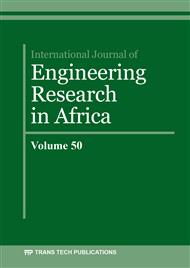[1]
Belarbi MT, Charif A. Développement d'un nouvel élément hexaédrique simple basé sur le modèle en déformation pour l'étude des plaques minces et épaisses. Revue européenne des éléments finis 1999; 8(2):135–57.
DOI: 10.1080/12506559.1999.10511361
Google Scholar
[2]
M. Himeur, M. Guenfoud « Elément fini flexionnel triangulaire doté d'un quatrième nœud fictif basé sur l'approche en déformation » Revue « Nature & Technologie ». n° 05/Juin 2011. Pages 43 à 56.
Google Scholar
[3]
Hamadi Djamal, Ashraf Ayoub and Ounis Abdelhafid (2016): A new flat shell finite element for the linear analysis of thin shell structures. European Journal of Computational Mechanics, Taylor and Francis, 24(6), pp.232-255,.
DOI: 10.1080/17797179.2016.1153401
Google Scholar
[4]
Abderramani Sifeddine, Maalem Toufik and Hamadi Djamal (2016): On improved Thin Plate Bending Rectangular Finite Element Based on the Strain Approach. International Journal of Engineering Research in Africa, ISSN: 1663-4144, Vol.27, pp.76-86, Trans Tech Publications, Switserland.
DOI: 10.4028/www.scientific.net/jera.27.76
Google Scholar
[5]
Abderrahmani S, Maalem T, Zatar A and Hamadi D. A New Strain Based Sector Finite Element for Plate Bending Problems, International Journal of Engineering Research in Africa, Vol 31, pp.1-13.Mars (2017).
DOI: 10.4028/www.scientific.net/jera.31.1
Google Scholar
[6]
Belarbi M.T., Développement de nouveaux éléments finis à modèle en déformation, application linéaire et non linéaire. Thèse de doctorat, Université de Constantine, Février 2000. 235 pages.
Google Scholar
[7]
Raju I.S. and Rao A.K., Stiffness matrices for sector elements, AIAA J.7,pp.156-157, (1969).
DOI: 10.2514/3.5054
Google Scholar
[8]
Sabir A.B. and Salhi H.Y., A strain based finite element for general plane elasticity in polar coordinates, Res. Mechanica 19, pp.1-16, (1986).
Google Scholar
[9]
Bouzerira C., Finite element analysis for general plane elasticity, Msc. Thesis, University of Walles College of Cardiff (G.B.), (1987).
Google Scholar
[10]
Belarbi M.T. et Charif A. Nouvel élément secteur basé sur le modèle de déformation avec rotation dans le plan). Revue Européenne des Eléments Finis, Vol. 7, N0 4, pp.439-458, juin (1998).
DOI: 10.1080/12506559.1998.10511312
Google Scholar
[11]
Hamadi. D Analysis of structures by non-conforming finite elements,, PhD Thesis, Civil engineering department, Biskra University, Algeria,2006, p.130.
Google Scholar
[12]
Ghannadiasl, A. and Noorzad, A. Bending Solution for Simply Supported Annular Plates Using the Indirect Trefftz Boundary Method, Civil Engineering Infrastructures Journal, 10 December (2015).
Google Scholar
[13]
Reddy, J.N. Energy principles and variational methods in applied mechanics, McGraw-Hill Pub. Co., New York (2001).
Google Scholar
[14]
Geminard L et Giet A, Stabilité des constructions, Paris (1971).
Google Scholar


